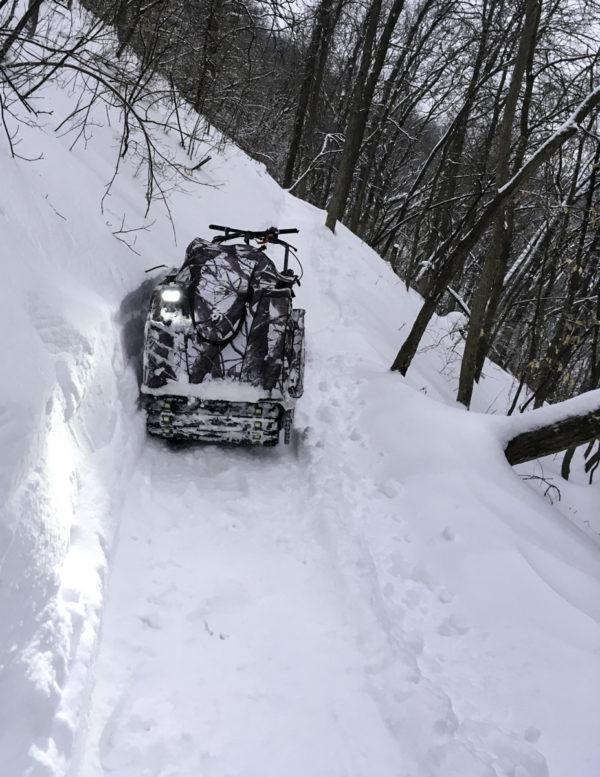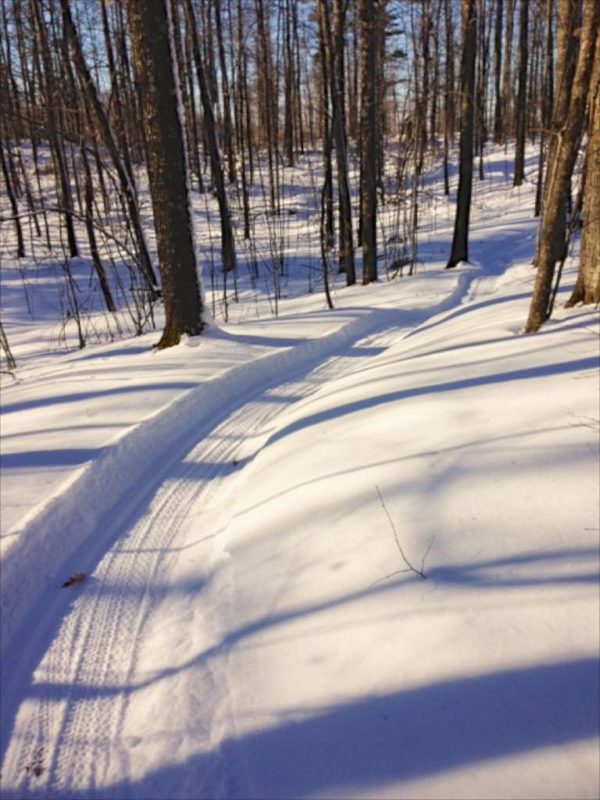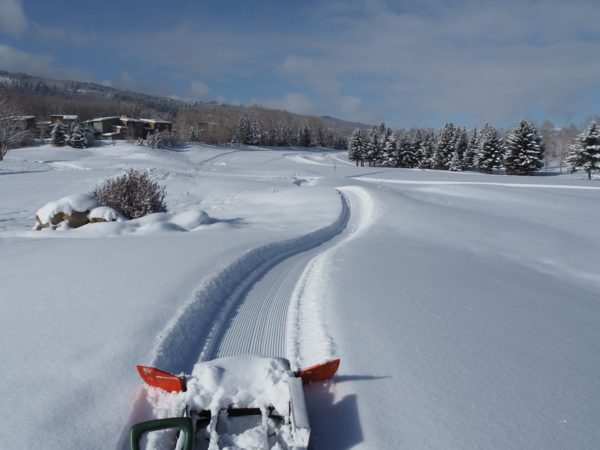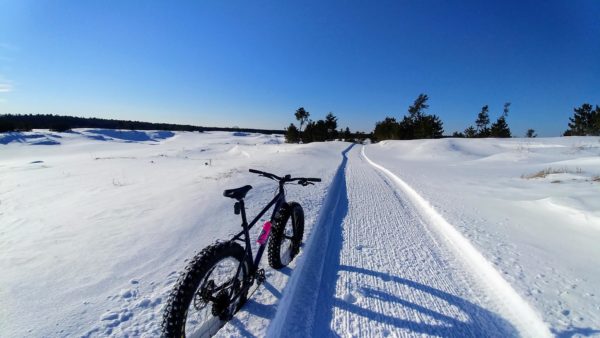Editor’s Note: Soon after I read the article below, I called and introduced myself to Joshua Blum. I learned that Josh is a long-time mountain biker and trail advocate. He was most recently the Trails Coordinator for ORA Trails out of La Crosse, and just started his own trail consulting company. I asked if we could share his thoughts about grooming and he was all for it. Josh shared that the guidelines are a good starting point and would like to hear from groomers that might have other ideas and experiences. Please let us know what you think and share your grooming experiences in the comments. ~gomez~
Evolution Trail Services Winter Fat Bike Grooming Best Management Practices
Winter fat biking is growing in popularity. Winter fat biking provides a great alternative to other more traditional winter sports such as XC skiing & snowshoeing as winter fat biking can be done on frozen ground or ground that has been lightly covered in snow. The following is a list of guidelines that will aid volunteers in providing the best possible conditions for winter fat biking. Like most winter sports, trails are groomed to provide a consistent quality surface for trail users.

When to / not to groom:
- Minimum snow depth/snowfall of 3”-4” system-wide (early season / when starting with no snow). Any less would not provide enough depth to effectively operate the machine without going down to the dirt surface.
- The minimum Air temperature of 32 Degrees and falling (note, XC Ski Groomers follow stricter guidelines on air temps being 26 degrees and falling).
- Once a solid base of snow has been established through grooming it may be necessary to groom after snowfalls of 2” or more for reestablishing the trail surface and consistent conditions.
- Drifting / Wind Blown Conditions – It may be necessary to re-groom after significant drifting events. Note the grooming protocol for drifting under the best management practices.
- Ice Events – it is not advisable to operate the machine on surfaces that are primarily ice and dirt.
Timing for Grooming:
- Universally, for all winter sports best time to groom is in the evening / late at night. The purpose of this is to allow the cooler overnight temperatures to set up the snow (make it harder). This is also the time that the trail is least likely to be used. Trail Use on freshly groomed surfaces may result in rutting / post-holing due to the surface being the softest at the time of grooming.
- Exceptions for grooming at night. While Night grooming is the most optimal time, early morning or day time grooming may be necessary under the following circumstances:
- Forecast snowfall is to exceed 8” – Day Time Grooming may be necessary to help pack snow during the snow event as the grooming equipment has a hard time in fresh snow depths deeper than 8”
- We are in a “Polar Vortex” – Day Time Grooming may be necessary as this might be the only time of the day that temps are manageable to groom in (Day time temps around Zero or lower, with subzero night temps in the forecast).
- It Snowed overnight, the snow is wet/heavy, and the day time temps are forecasted to rapidly decrease throughout the day. This should be performed as early as possible in the morning to still allow the snow to set up ahead of regular use.

Other best Management Practices for Grooming:
- Weight Biased Side – The Snowdog (Compact B13ME) is weighted more on the left side due to its design. Other machines may be weighted differently, pay attention to this as understanding how the machine tracks on cross slopes can work to your advantage, or make things much more difficult. Certain trails will need to be groomed in certain directions based on where the weight biased of the machine is located relative to the high side of the trails. Please consult with experienced groomers if questioning what direction to groom is best for each trail. Proper planning will provide a much more desirable grooming and user experience, and be more efficient for groomer operators.
- Multiple Passes – The main goal for grooming is to push the air out of fresh snow so it can set up firm for use. Think Quality VS Quantity! It’s usually better to pick a trail or set of trails to groom while allowing yourself the time to make an additional pass or two on these trails during your grooming session. While making additional passes, where ever possible offset subsequent passes to allow for some trail widening.
- Grooming for Drifting – This might be one of the most difficult tasks performed with the Snowdog, as the Snowdog likes to track up drifts and tip over vs going directly through drifts. If it has been determined that there is significant drifting over a section of trail the following steps may be necessary for both providing a good end product and for the safety of the Groomer Operator and Equipment.
- Stomp through the drifted area several times with boots on the side of the trail that is nearest to the back slope / farthest from out outside edge with the goal of creating a bench. This may take a lot of time and effort but spending the time to perform this is necessary.
- Creep the groomer through the drifted location slowly while attempting to get the machine to lean into the drift (the easiest way to do this is to have the left side of the machine tip into the high side of the drift/trail so forethought into the direction you are going to groom on each trail is necessary).
- What not to do – Do not attempt to just blast the groomer through drifts – this has been attempted before (many times in fact). This usually leads to the machine tracking off the trail (best case) or the machine rolling over (big pain in the butt/back).
For all grooming efforts, it may be necessary to make a call out on social media for people to snowshoe/pack snow ahead of grooming efforts when we have received larger than 8” snow volumes. Do not be afraid to do this. Many People love to help where they can.
Note: Grooming should only be performed as needed, over-grooming may result in a less than desirable snow surface and cause unnecessary wear to our grooming equipment ($$$). Ultimately, Grooming for Fat Biking makes the trails manageable for fat biking. Once Groomed, the trails will usually get better the more passes they see with use as tires will help compact the snow surface better than the groomer can (think of sheep’s-foot rollers used for compaction in construction and grading).
Maintenance issues with Equipment: Please Report all possible maintenance issues with equipment to the equipment manager/person responsible for equipment so these issues may be addressed asap.
Transparency and Team Work: It is best to keep all volunteers who are associated with Winter Fat Bike Grooming up to speed on the work we perform/planning to perform. This will promote transparency and trust within the group, minimize the duplication of efforts, and provide an open learning experience as we all likely learn something new every time volunteers go out to groom.

Note: The above information is based on my personal experience with learning how to groom with the Snowdog. I do not view this information as absolute and look forward to others sharing their knowledge as well.
About Evolution Trail Services
Evolution Trail Services LLC was started in December of 2019 by Josh Blum after serving as a Volunteer, Crew Leader, and Trails Coordinator of the Outdoor Recreation Alliance of the 7 Rivers Region (ORA Trails).
My Background / Experience with Trails and Snow: I started mountain biking in summer 0f 1991, in La Crosse, WI. Mountain Biking provided an alternative to traditional sports as the typical traditional / team sports didn’t fit. I’ve been hooked on mountain biking, and trails ever since.
Fast Forward to the mid-2000s, I became active with the local trail organization Human Powered Trails in La Crosse WI. Like most, becoming involved with the local trail organization was a way to help out and improve trail experiences for all users. I also found that it was useful to pair my professional background at WisDOT in Design / Construction and Highway Maintenance with Trail Work. Around 2011 Human Powered Trails became the Outdoor Recreation Alliance of the 7 Rivers Region (ORA Trails). After this transition, I became more active which lead to a role as a Crew Leader, and ultimately to the role of Trails Coordinator. I feel very fortunate to have had the opportunity and freedom to lead hundreds of volunteers, who have tallied thousands of hours of trail work in the La Crosse Area. Volunteering for ORA Trails has also provided additional training such as Trail Master Certification and Mechanized Trail Building through Trail Design Specialists, along with numerous chainsaw safety courses.

You are probably wondering where the snow experience comes in. I’ve been a lifelong alpine skier/ski racer, and snowboarder, in 2005 I started coaching for both the Alpine Ski Program and Snowboard Team at Mt La Crosse. The natural progression here was also to become an Alpine Official for ski racing. One of the focuses as an Alpine Official is “Chief of Course” the Chief, of course, is the official that is responsible for the surface of the racecourse/course conditions. This is a demanding aspect of the sport as the best courses have the most consistent snow surfaces so races can be as fair as possible. Spending tens of thousands of hours on snow came in handy when it was time for my local trails club to purchase a Snowdog for grooming Single Track during Winter 2016 / 2017. Since this time, I’ve trained numerous other volunteers on how to efficiently operate the Snowdog.
In an ironic twist, my current role at WisDOT has me working in Highway Maintenance which means I’m heavily involved with winter maintenance operations – removing/treating snow-covered highways, there is a bunch of science here as well. No matter the time of the year when you pair trail work with my job at WisDOT it seems like I’m always performing maintenance for some form of transportation both on highways and trails.
One main objective with Evolution Trail Services is to share the knowledge that I’ve learned with the masses in an effort to help improve trail users’ experiences where ever possible. I’m also looking forward to learning trail knowledge from others as together we can collectively improve trails for all.
Stay tuned for more trail-based articles and podcasts.
For more information on Josh and Evolution Trail Services head over to www.Evotrails.com

Great article. Can you speak to the maintenance needs of the snowdog, and overall durability?
Have you found that using reverse is mandatory, or can you plan around not needing it?